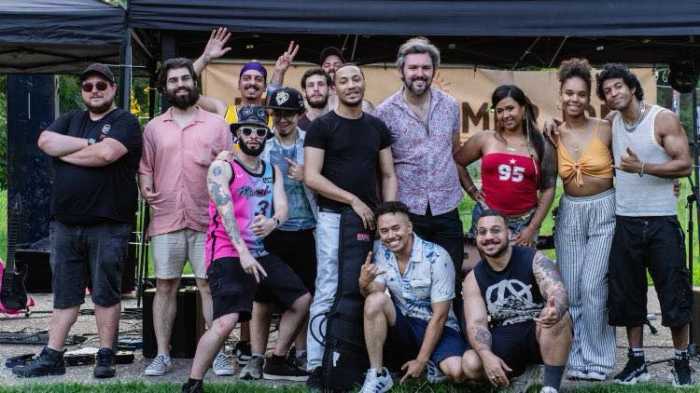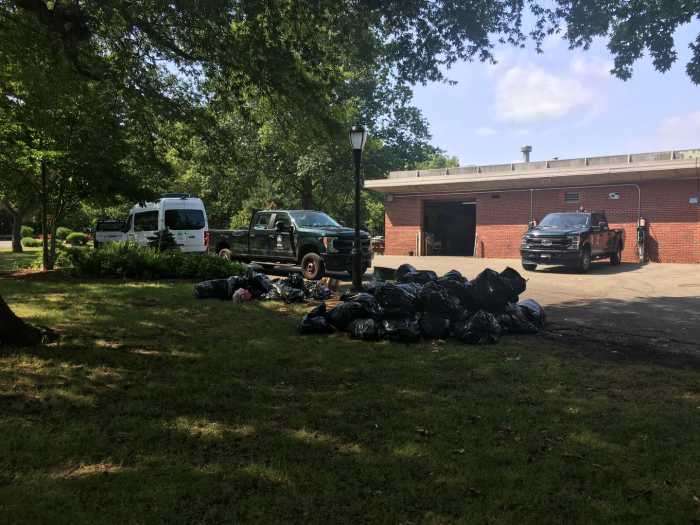Wednesday July 31, a procession of New Yorkers, accompanied by music and visuals capturing the aftermath of Hurricane Sandy, marched from the Staten Island Ferry Terminal to City Hall to release a plan on post-Sandy rebuilding for the mayoral candidates to adopt.
The Alliance for a Just Rebuilding (AJR), a coalition of Sandy-impacted New Yorkers, labor unions, and community, faith, environmental and policy organizations, released a major new rebuilding plan developed by people working and living the communities hit the hardest by Sandy.
Key decisions on post-Sandy rebuilding will be made by Bloomberg’s successor, and many AJR member groups and organizations today called on the mayoral candidates vying to succeed Bloomberg to make specific commitments to good jobs, affordable housing, sustainable energy, and community engagement to ensure an equitable rebuilding of our city.
The post-Sandy rebuilding plan, Turning the Tide: How Our Next Mayor Should Tackle Sandy Rebuilding, focuses on the fact that Sandy exposed deep inequities that existed long before the howling winds and flooding bore down on the city last fall, and reveals that our next mayor’s legacy will be defined by whether those inequities are transformed or neglected.
“Making New York stronger and more resilient for all, and especially for the most vulnerable, is the single most important challenge facing our next mayor. This platform briefly lays out some concrete and realistic steps that Bloomberg’s successor can employ…to redress and reduce the inequities that faced our city long before Hurricane Sandy,” the AJR rebuilding plansays.
The plan lays out a four-point agenda for turning the tide away from inequality toward justice:
1. Our Next Mayor Should Ensure That Sandy Recovery And Rebuilding Dollars Create Thousands Of Good Local Jobs.
2. Our Next Mayor Should Restore Lost Affordable Housing, and Create New Affordable Housing for Displaced Residents to Preserve Community Ties
3. Our Next Mayor Should Invest in Clean, Sustainable Energy Infrastructure that Values Communities and is Accountable to the Public.
4. Our Next Mayor Should Include and Engage Communities in Sandy Recovery – and in Planning NYC’s Future.
Policy recommendations and proposals for each of the four areas are as follows:.
“Those who were struggling the most before Sandy are still suffering the most in the recovery. For New Yorkers to fully recover, ‘resiliency’ must come in the form of good jobs, job training programs, and real affordable housing. Economic development in post-Sandy New York must lift all boats, not only the yachts of the real estate industry,” Pastor David Rommereim of Good Shepherd Lutheran Church and a leader of Faith in New York.
“Hurricane Sandy left devastation and innumerable tragedies in its wake, but with rebuilding comes hope and opportunity. We can make our communities stronger. As we rebuild, the City must ensure that new housing is storm-secure and affordable to those who were displaced, and that the jobs created by the rebuilding allow our neighbors who were affected to lift themselves up with safe work at a family-sustaining wage,” said Kyle Bragg, Secretary-Treasurer, 32BJ SEIU
“A lot of precious post 9/11 disaster money ended up going to big real estate and financial institutions to help build luxury apartments in lower Manhattan that not even the firefighters and first responders who valiantly rescued people when the towers fell could afford to live in. This cannot happen again. As Sandy money gets allocated, we need our new mayor to direct city entities, particularly the Economic Development Corporation, to put the needs of low-income and vulnerable New Yorkers first and ensure good jobs and affordable housing result from these new investments,” said Bobby Tolbert, a member leader with VOCAL-NY.
“Public housing was suffering from neglect pre-Sandy, and the problems have gotten worse. Repairs aren’t getting done and mold problems are expanding. There’s rain coming through the 11th Floor, and the roof still has not been repaired. Money needs to get to public housing developments and residents need to be able to get the work. There needs to be more involvement with the community to develop a plan. Public housing residents are being left out of the discussion and forgotten. If the real voice of the people was at the table, decisions and priorities would be different,” said Vernell Robinson, a Community Voices Heard (CVH) member-leader and Carleton Manor resident in Far Rockaway, Queens.
“After Sandy, we were the first to help families remove water from flooded basements, clean up debris removal, demolition, and other home infrastructure repairs in the coastal areas of the city. As the city seeks to invest in the rebuilding, it is necessary to ensure responsible contractors are creating good job opportunities with justice, dignity and respect,” Eudes Salas, a day laborer and member of the Workers Justice Project
“We proudly support the AJR agenda to turn the tide to aid the victims of Hurricane Sandy to recover by allocating new affordable housing, adding thousands of local good jobs and providing a voice to the community in planning their future,” said Byron Silva, a leader of Liuna Local 10.
“In the immediate aftermath of Hurricane Sandy, elected officials in and around New York City were courageous and correct in attributing the unprecedented destruction of our City to the global threat of climate change. Recognizing that greenhouse gases are a major cause of increasingly violent storms, we are committed to the idea that reconstruction and rebuilding work should be performed to the highest energy efficiency standards possible. Enforcing green standards in rehabilitation work and pursuing community-based renewable energy generation projects both enhances the sustainability of our shared built environment, and serves to maintain the affordability of housing for low-income populations,” said Jay Ackley, a program manager and analyst at the Community Environmental Center






















